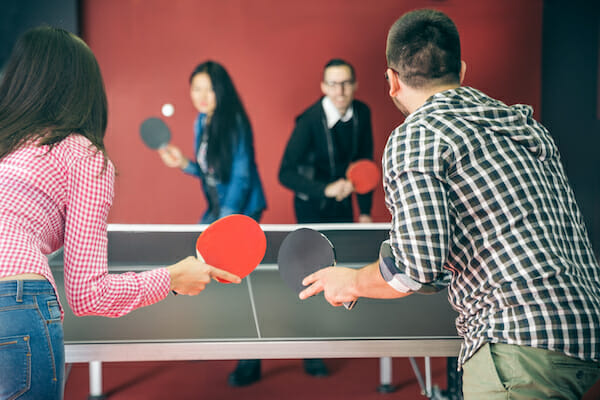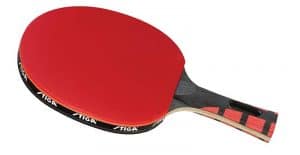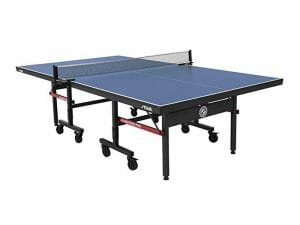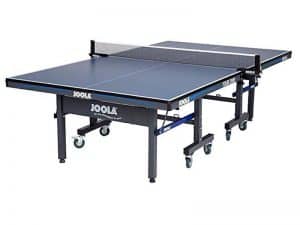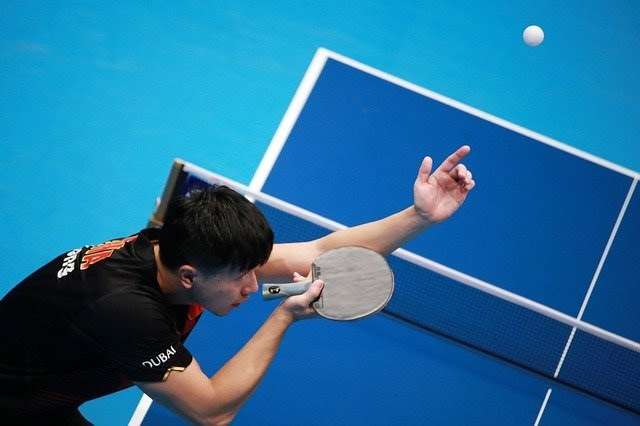Ping Pong Doubles Rules Explained: How to Play Table Tennis Doubles
- Alex Horscroft
- Last updated
While doubles table tennis is largely the same as singles, there are many rules that people are unaware of. For starters, many players think whoever is closest can hit the ball, but this is not the case.
The ping pong doubles rules state that you and your partner must alternate hitting the ball. If either of you strikes it out of sequence, you lose the point. Unlike singles, doubles also require you to serve diagonally from the right.
Of course, you need to understand more when it comes to doubles, and I’m here to tell you everything you need to know! I play doubles regularly and also umpire plenty, too. By the end of this post, you’ll know exactly how to play ping pong doubles.
Table of Contents
Rules for Ping Pong Doubles
As most players favor singles, it’s quite common for them to know some, but not all, of the rules for table tennis doubles. Fundamentally, ping pong doubles rules build upon the rules of singles but make them stricter. Most of the rules are the same. For instance, if you strike the net on a serve but it is otherwise a good service, you get to have another attempt.
Here are some similarities between both games:
- Ensure equipment compliance: rubbers, blades, rackets, standard white or orange balls (plastic, not celluloid), etc
- Change of service after two serves
- Serves must be thrown from the open palm of the server
- Serve from behind the server’s end line and throw the ball from above the level of the playing surface
- If the ball strikes any part of the net assembly on an otherwise legal serve, a let occurs
- Games are first to 11 points
- Failure to make a good return results in the loss of a point, e.g., leaning on the table, moving the table, hitting the ball onto the side of the table
- If you win the coin toss, you choose which team serves or a particular end to play first
Below, you’ll learn about the differences between singles and doubles table tennis rules.
Table Requirements
Before we get into gameplay specifics, you need the right table to play doubles. Fortunately, over 99% of tables are eligible. The distinction here between doubles and singles is that the rules explicitly state that the table must include a white center line. This is essential as doubles serving uses this center line to create equal half-courts to help identify whether a serve is legal or illegal.
As I say, almost all tables have this white center line. The only ones that don’t are designer tables, outdoor tables, and select models by Killerspin.
Ping Pong Doubles Serving Rules
Learning how to play doubles in ping pong begins with serving, and unlike singles games where you can serve anywhere on the table, the rules of ping pong doubles restrict where the ball can bounce. This is where the white center line comes in — it breaks the table into four quarters.
For paired-up play, the ping pong serve rules for doubles state that you must serve on the right sides of each half of the table. The ball must bounce once on your right half-court and at least once on the receiver’s right half-court. If the ball lands on the center line, it counts as in, and if you fail to adhere to this rule, you lose the point.
Besides this rule, serving is exactly the same as singles! So make sure you are serving with the open palm of the free hand and throwing up the ball high enough!
Ping Pong Doubles Rules Point Format
Fortunately, the point format for doubles is exactly the same as it is for singles, so there is nothing new to learn here. You play games first to 11, and either team must win by a 2-point clearance.
Matches are commonly played best of 5 games. However, you can also play double games to best of 3 or best of 7 games.
Read More: Ping Pong Table Dimensions: Learn the Official Size & More!
Alternate Hitting Table Tennis Rules for Doubles
Casual players may allow whoever is closest to the ball to play the shot, but this breaks the order of play as specified in the rules of doubles ping pong. To follow ping pong doubles rules accurately, players must alternate hitting the ball from the very beginning of the match.
Example
To better understand the sequence, imagine two teams with players A & B and X & Y.
Player A serves to player X, who makes a return. Following this, player B must strike the ball, followed by player Y.
This same sequence of A, X, B, and Y continues until a winner emerges.
If a team breaks the sequence, they forfeit the point.
Table Tennis Serving and Receiving Doubles Sequence Rules
Before the first game of a doubles match can commence, a serving team must be selected. This is achieved through random means. Commonly it’s a coin toss, however, more casually, the umpire will hide the ball in one hand and have you guess which it is.
Once a team has been selected to serve for the first game of a match, that team decides which player will be the first server. The opponent’s team then has the luxury of selecting which of them would like to be the first receiver. The partner of the previous server takes their turn serving after two points conclude.
In the event teams are tied at 10-10 towards the end of the game, service switches after every point, so receiving players only have to wait one point before serving, not two. The winner is the first team to achieve a 2-point clearance. For each game, the sequences of serving change.
In the next game of the match, the original receiving team decides who would like to serve first. However, this time around, the opposing team cannot choose the receiving player. The receiver is, instead, whoever the server did not serve in the previous game.
Example
If in the preceding game, player A serves to player X, then in the successive game, if player X chooses to serve first, the receiver is player A.
Subsequent games of the match proceed much like the second game. The serving team gets to choose which of them has the start of service. As for the receiving pair, the player who served to the current server in the previous game receives in this one.
Swapping Ends in the Final Game
In the interest of both fairness and probably a desire to spice things up a bit, the teams swap ends of the court halfway through the last possible game of a match. The partner of the receiver also changes positions instead of receiving the serve. You swap when one of the pair scores reaches 5 points.
As the previous receiver swaps with their partner, they strike the ball fourth rather than second in the sequence.
Important to note: This only happens in the last possible game of a doubles match. Therefore, this extra end swap and receiver switch only occur for close matches.
Example
At the change of ends, if player A was serving to player X, they instead served to player Y.
Ping Pong Doubles Rules for Wheelchair Players
Wheelchair rules apply to your team if at least one of you is in a wheelchair due to a physical disability. And the only change it makes is to the order of play and your positioning.
Unlike normal doubles ping pong rules, you are not mandated to alternate between striking the ball. Instead, either doubles partner may hit the ball. However, this leniency is in place for good reason. Each of you must remain in your own half, one on the left and one on the right (imagine an extension of the table’s center line).
What’s more, the table tennis doubles rules for wheelchair users, specifying that you must follow the standard beginning sequence of play. This means the server shall serve, the receiver shall receive, and only then are either of you free to hit the ball.
As for the opposing pair, they follow the standard rules provided neither of them are in a wheelchair.
What Happens in the Event of a Sequence Mistake?
If a mistake occurs regarding who is serving or receiving, or if you forget to change ends, temporary suspension of the game will occur. However, all prior points accrued remain. You then correct the sequence to what it was when the game began.
As there are many rules to follow on top of the standard singles rules, mistakes in ping pong doubles are quite common. This is why it’s best to have an umpire keep track of the game.
Read More: Table Tennis Beginners Guide
Congrats! You Now Know the Ping Pong Doubles Rules!
Now that you know the ping pong doubles rules it’s time to hit the table.
Doubles in table tennis is a great way to break up the sometimes monotonous drills we do to improve our performance for singles. It provides a fresh format, improves our analytical skills, and even improves our service accuracy. These are skills we can all translate back to singles, so I can’t really see a reason why you wouldn’t want to give it a go!
Who knows? You could even become a ping pong doubles specialist in the future! Just look at Lim Jonghoon. He sits second in the world with Jang Woojin for doubles as of December 2024. This easily beats out his world ranking of 17th for singles.
Looking for a new paddle to level up your table tennis skills? Check out our Best Ping Pong Paddles Guide.
Read More: Ping Pong vs. Table Tennis
Frequently Asked Questions
Do You Have to Alternate for Table Tennis Doubles?
Yes, you must alternate with your partner when striking the ball in doubles. You also alternate the order of play. So after performing your two serves, the serving switches to your opponents, and your partner switches to receive the ball. They then receive twice before getting their two serves.
How Many Points Is a Doubles Game of Table Tennis Played To?
A doubles game is always played first to 11 points. However, the number of games played varies. Usually, it is the best of 5 games. However, some people play the best of 3 games or best of 7 games as well.
Is One Member of a Doubles Team Allowed to Play Alone Against the Opponents?
No, one player cannot play alone against two people in doubles. This is because doubles table tennis rules specify that you must alternate striking the ball with your partner. Without a partner, you have nobody to alternate with and are therefore at a major advantage.
Is It a Mistake if the Wrong Player Serves or Receives?
If the wrong player serves or receives, an error has been made. It is the responsibility of the umpire to fix such errors and resume the ordinary sequence of play. All points scored after the error remain.
Is the Center Line Out of Bounds When Serving?
The center line is in, but due to how thin it is it can be difficult to tell whether the ball lands on it, or whether it is in or out. For this reason, you should avoid serving too close to the center line.
How Is the Ball Served in a Doubles Game?
You must serve diagonally from the right into the service boxes. The ball must bounce once on your side of the court and at least once on the receiver's court. This differs from singles where you can serve anywhere.
What Happens If I Serve to the Left of the Center Line But It Lands on the Right Half Court of My Opponent's Side?
The table tennis doubles serving rules are clear that the ball must land in the right service boxes on both sides of the table. Therefore, such a service is illegal.
Freelance writer. Table tennis enthusiast. Lover of all things online. When I’m not working on my loop game I’m probably binge-watching some fantasy show.
-
Alex Horscrofthttps://pingpongruler.com/author/alex-horscroft/
-
Alex Horscrofthttps://pingpongruler.com/author/alex-horscroft/
-
Alex Horscrofthttps://pingpongruler.com/author/alex-horscroft/
-
Alex Horscrofthttps://pingpongruler.com/author/alex-horscroft/
Popular Products
Join our email list for exclusive reviews & the latest Ping Pong News
Sign up to our newsletter and stay up-to-date with the latest news in the ping pong world, and be the first to read our new product reviews. We promise, no spam



